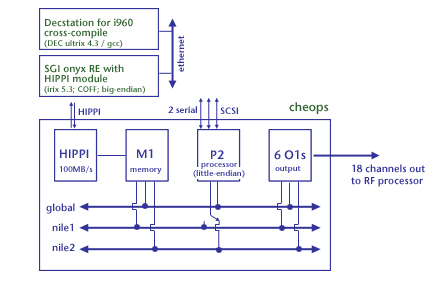| |
Cheops
is an image processing system developed by the Entertainment
and Information Systems group at the MIT Media Lab. It was
designed to be a modular and bus-oriented system, and was
intended for video coding and other image processing -intensive
applications. The hybrid cheops system shown above was developed
for our holographic video experiments.
Cheops
M1, P2, and O1 modules are connected to each other through
two types of buses as shown above, the Global bus and the
Nile. The slower, 32-bit Global bus is used primarily for
supervisory communication and for small data transfers between
modules. The two 24-bit Nile buses (120MB/s) are used for
high speed transfer of large blocks of data; the two Niles
may be used independently, but each module can engage only
one Nile transfer at a time. Further, only one module can
drive a Nile bus at a given moment in time, but several modules
can receive data from the Nile simultaneously.
The
P2 contains 32MB (8 banks of 4MB each) of dual-ported memory,
the local processor (an Intel 80960CA Microcontroller), and
additional special-purpose processing units as well. The P2
supports two serial connections, and a SCSI interface to the
host computer. In our setup, we use an SGI Onyx (running Irix
5.3) as the host. Cheops programs are cross-compiled for the
P2's' i960 on a Decstation (running DEC ultrix 4.3), and are
downloaded from the host SGI, initiated and communicated with
by the chex (cheops execute) utility, also running
on the host SGI. For instance, utilities for loading and displaying
both single and sequences of hologram frames (along with hologram
data) are downloaded to and executed on the P2 in this fashion.
Approximately
10 36MB holograms can be downloaded and stored on Cheop's
M1 memory module, from which they can subsequently be transferred
rapidly, via the Nile, to the output cards for display. Holograms
can be slowly loaded from the host to the M1 over the SCSI
link (at about 10Mbits/s), or can be sent via a faster HIPPI
connection (100MB/s) to either the M1 or the O1s for immediate
display. The latter is the fastest channel available from
a host machine to the output cards.
Holovideo's
cheops has 6 O1 output modules which function as the display
framebuffer. The O1s are configured to support the unconventional
aspect ratio of the mark-II's holographic frames (256Ksamples
x 144). The O1s represent and display data in rgb format;
to take advantage of this built-in3-channel structure (reflected
throughout cheops), we store and transfer our hologram lines
in groups of three, called triplets.
So for instance, instead of outputting 3 channels of (r,g,b)
plus sync, a single O1 outputs hologram lines (0,1,2) or (18,19,20)
plus sync. All together, the 6 O1s clock 18 hologram lines
out of cheops simultaneously; after 8 cycles, all 144 hologram
lines have been sent out to the display.
We
are currently phasing out
cheops, the cross-compile environment and the host computer,
and are replacing them with a newer computational subsystem
(CHIDI),
also being developed at the Media Lab for the mark-II holovideo
system.
For more information on cheops, visit the cheops
project page, or the cheops
publications page.
|
|

